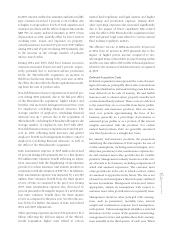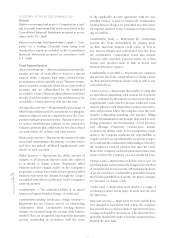American Express 2004 Annual Report Download - page 66
Download and view the complete annual report
Please find page 66 of the 2004 American Express annual report below. You can navigate through the pages in the report by either clicking on the pages listed below, or by using the keyword search tool below to find specific information within the annual report.
Risk Management
At AEFA, interest rate exposures arise primarily with
respect to its insurance, annuity and investment certifi-
cate products. Rates credited to customers’ accounts
generally reset at shorter intervals than the yield on
underlying investments. Therefore, AEFA’s interest
spread margins are affected by changes in the general
level of interest rates. The extent to which the level of
rates affects spread margins is managed primarily by a
combination of modifying the maturity structure of the
investment portfolio and entering into swaps or other
derivative instruments that effectively lengthen the rate
reset interval on customer liabilities. Interest rate
derivatives with notional amounts totaling approxi-
mately $1.4 billion were outstanding at December 31,
2004 to hedge interest rate exposures. Additionally,
AEFA has entered into interest rate swaptions with
notional amounts totaling $1.2 billion to hedge the
impact of increasing interest rates on forecasted fixed
annuity sales.
The negative effect on AEFA’s pretax earnings of a 100
basis point increase in interest rates, which assumes
repricings and customer behavior based on the applica-
tion of proprietary models, to the book of business at
December 31, 2004 and 2003 would be approximately
$58 million and $53 million for 2004 and 2003 (including
the impact of minority interest expense related to the
joint venture with AEB), respectively.
AEFA has two primary exposures to the general level
of equity markets. One exposure is that AEFA earns
fees from the management of equity securities in vari-
able annuities, variable insurance, proprietary mutual
funds and other managed assets. The amount of fees
is generally based on the value of the portfolios, and
thus is subject to fluctuation with the general level of
equity market values. To reduce the sensitivity of
AEFA’s fee revenues to the general performance of
equity markets, AEFA may from time to time enter into
various combinations of financial instruments that miti-
gate the negative effect on fees that would result from
a decline in the equity markets. The second exposure
is that AEFA writes and purchases index options to
manage the margin related to certain investment certifi-
cate and annuity products that pay interest based upon
the relative change in a major stock market index
between the beginning and end of the product’s term.
At December 31, 2004, equity-based derivatives with a
net notional amount of $283 million were outstanding
to hedge equity market exposures.
The negative effect on AEFA’s pretax earnings of a 10
percent decline in equity markets would be approxi-
mately $85 million and $89 million based on assets
under management, certificate and annuity business
inforce and index options as of December 31, 2004 and
2003, respectively.
AEFA’s acquisition of Threadneedle resulted in balance
sheet exposures to foreign exchange risk, which is
managed primarily by entering into agreements to buy
and sell currencies on a spot or forward basis. At
December 31, 2004, foreign currency products with
total notional amounts of approximately $870 million
were outstanding. Based on the year-end 2004 foreign
exchange positions, the effect on AEFA’s earnings and
equity of a hypothetical 10 percent change in the value
of the U.S. dollar would be immaterial.
AEFA’s owned investment securities are, for the most
part, held to support its life insurance, annuity and
investment certificate products, which primarily invest
in long-term and intermediate-term fixed income
securities to provide their contractholders with a com-
petitive rate of return on their investments while con-
trolling risk. Investment in fixed income securities is
designed to provide AEFA with a targeted margin
between the interest rate earned on investments and
the interest rate credited to clients’ accounts. AEFA does
not trade in securities to generate short-term profits for
its own account.
AEFA’s Balance Sheet Management Committee and the
Company’s ERMC regularly review models projecting
various interest rate scenarios and risk/return measures
and their effect on the profitability of the Company.
The committees’ objectives are to structure their invest-
ment security portfolios based upon the type and
behavior of the products in the liability portfolios to
achieve targeted levels of profitability within defined
risk parameters and to meet contractual obligations.
Part of the committees’ strategies include the use of
derivatives, such as interest rate caps, swaps and floors,
for risk management purposes.
AXP
AR.04
64
Financial Review
























